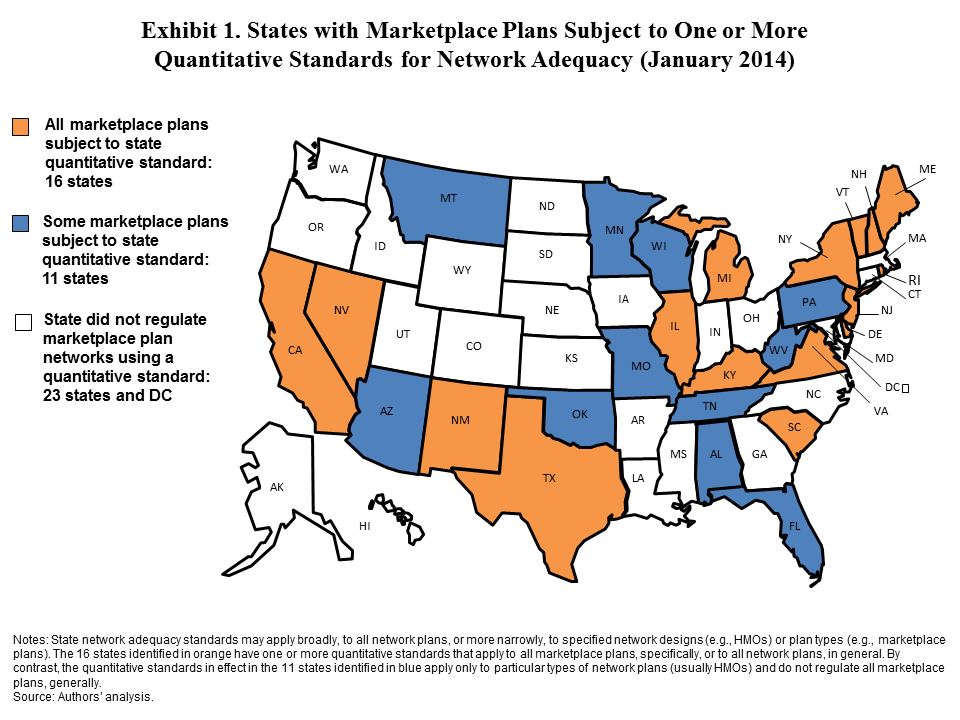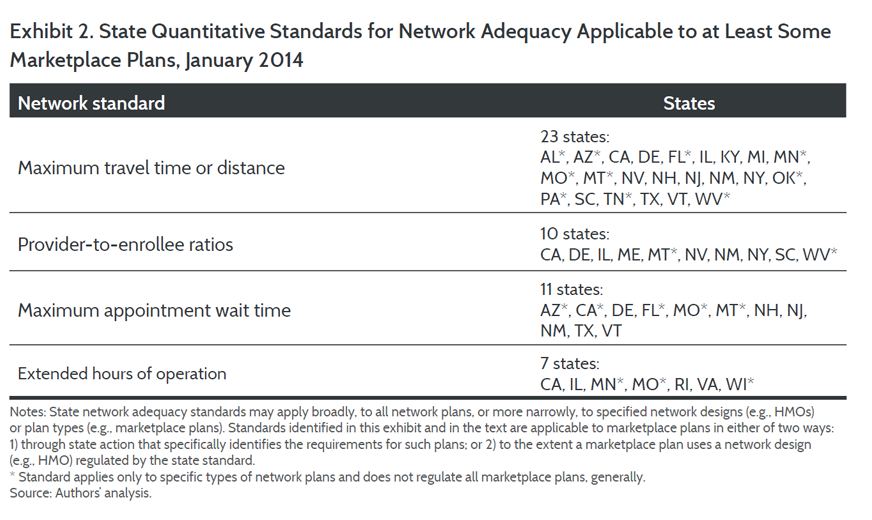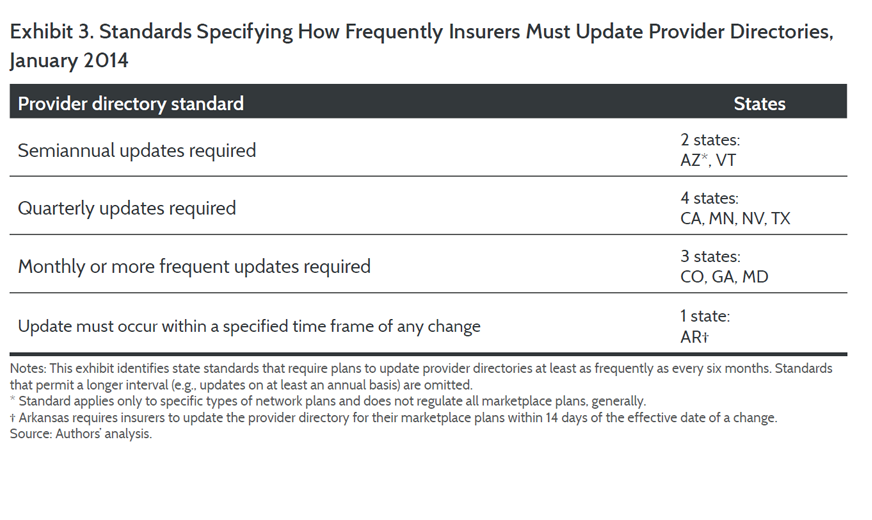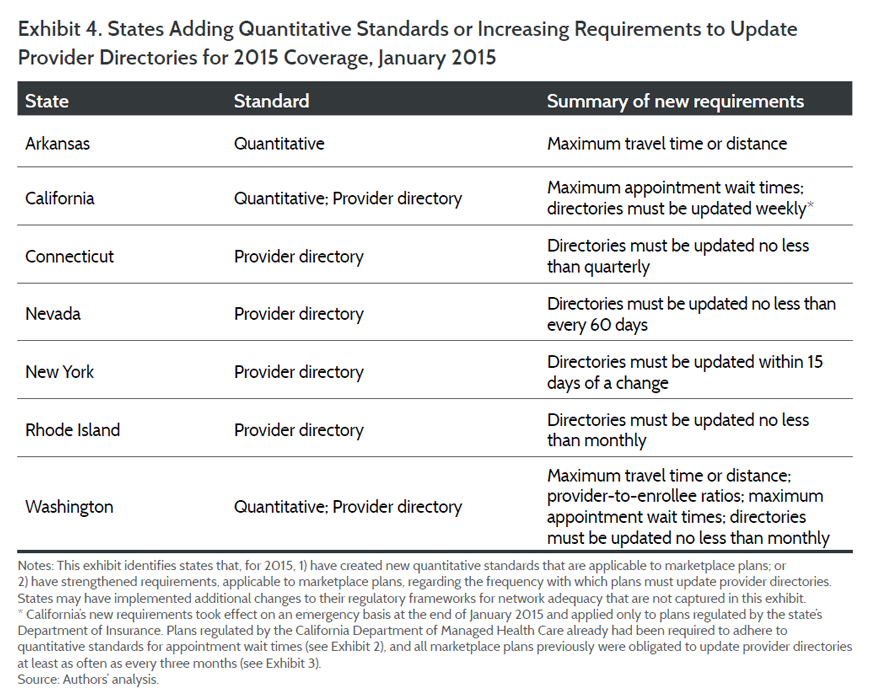Abstract
Health plans with relatively narrow provider networks have generated widespread debate, mainly concerning the level of regulatory oversight necessary to ensure plans provide consumers meaningful access to care. The Affordable Care Act creates the first federal standard for network adequacy in the commercial insurance market for plans offered through the law’s insurance marketplaces. However, states continue to play a primary role in setting and enforcing network rules. This brief examines state network adequacy standards for marketplace plans in the 50 states and District of Columbia. We identify state requirements in effect at the outset of marketplace coverage, focusing on quantitative measures of network sufficiency and rules designed to ensure the delivery of accurate and timely provider directories. We then explore the extent to which those standards evolved for 2015. Though regulatory changes were limited in year one, states were most likely to act to promote network transparency and enhance oversight.
OVERVIEW
“Narrow network plans”—that is, health plans with limited networks of providers—were common on the Affordable Care Act’s (ACA’s) health insurance marketplaces in 2014. By one measure, almost half of all marketplace plan networks were “narrow” and nearly all consumers had access to buy such a plan if they chose.1 These narrow network plans are not new nor are they unique to the ACA’s marketplaces; for years, insurers have used limited networks as a way to constrain costs and regain leverage in contract negotiations with providers.2 At the same time, elements of the ACA that encourage insurers to compete on price—for example, marketplaces that allow consumers to compare plans based on premiums and increased standardization of benefits and cost-sharing—appear to have spurred many carriers to design health plans for 2014 that combined an attractive premium with a more restricted choice of providers.3
Narrow network plans may offer value to many consumers if their comparatively lower upfront costs are coupled with meaningful access to a sufficient array of providers. Flexibility to contract selectively also may allow insurers to build networks of providers who can satisfy measures of quality and efficiency, which may lead to higher-value care. But these plans also pose risks. If a network is too narrow, it may jeopardize consumers’ ability to obtain critical services or expose them to the often significant financial costs of out-of-network care. If the design is not transparent—that is, if consumers do not receive accurate and timely information about participating providers—it may be impossible for consumers to make an informed decision about whether the plan’s combination of network and price is right for them.
To help ensure that plans offered on the marketplaces serve the needs of enrollees, the ACA established a national standard for network adequacy.4 Marketplace plans must maintain “a network that is sufficient in number and types of providers” so that “all services will be accessible without unreasonable delay,” and are required to disclose their provider directories to the marketplace for online publication.5
These provisions offer consumers federal protections where previously none existed. Yet the federal framework also gives states significant latitude to determine whether an insurer has complied with the requirements, as well as the power to enforce additional, state-specific network rules if desired.6 Prior to the ACA, most states had some standards governing plan networks. Heading into 2014 and the first year of marketplace coverage, these state rules, depending on their scope, began to apply to some offerings on the marketplaces. Meanwhile a minority of states took steps to create new requirements for marketplace coverage.
This brief describes the network adequacy standards applicable to marketplace plans in each of the 50 states and the District of Columbia at the outset of marketplace coverage in 2014.7 In particular, we focus on quantitative standards that states have set to test the sufficiency of provider networks, and on requirements designed to ensure that consumers have access to updated provider directories. Then we identify the extent to which those requirements evolved in preparation for year two.
FINDINGS
In the First Year of Coverage, About Half of States Had One or More Quantitative Standards to Measure the Adequacy of Marketplace Plan Networks
By January 2014, nearly all states had rules intended to promote the sufficiency of health plans’ provider networks. In general, these standards seek to ensure that enrollees have reasonable access to in-network providers who perform the health services covered by their insurance policy. However, the particulars of these requirements vary substantially. In many states the rules apply only to a subset of plans—for example, health maintenance organizations (HMOs)—that use a specific network design. The timing and frequency with which these standards are applied differ, as well. In many states, regulators conduct network adequacy reviews only when an insurer initially seeks licensure, upon notice of a significant change in a plan’s network, or in response to complaints. Oversight on an ongoing basis is much less common.8
Twenty-one states had qualitative standards to assess the adequacy of plans’ provider networks. For example, Maryland requires carriers to maintain a panel of in-network providers that is “sufficient in numbers and types of available providers to meet the health care needs of enrollees.”9
Kansas uses a similar formulation, requiring a “sufficient” mix of in-network providers so enrollees can access all covered services “without unreasonable delay.”10 These approaches, variations of which are common in other states, resemble key provisions of a 1996 model law developed by the National Association of Insurance Commissioners (NAIC).11
In contrast, 27 states had rules requiring at least some network-based marketplace plans to satisfy one or more quantitative measures of sufficiency (Exhibit 1). These standards took different forms (Exhibit 2). Most frequently, states specified the maximum amount of time and/or distance an enrollee must travel to access covered services. Twenty-three states had such requirements in place at the start of 2014, including New Jersey, which obligates its managed care plans to have available at least two primary care physicians within 10 miles or 30 minutes driving or public transit time of 90 percent of its enrollees.12
Eleven states impose limits on how long enrollees can be made to wait for appointments for services. Montana, for example, requires managed care plans to ensure access to urgent care within 24 hours; nonurgent care with symptoms within 10 days; immunizations within 21 days; and routine or preventive services within 45 days.13 Nearly as many—10 states—have standards prescribing minimum ratios of providers to enrollees. Nevada requires that its marketplace plans adhere to ratios for internal medicine providers (at least one for every 2,500 covered persons) and for certain specialized services (e.g., one cardiology provider for every 7,500 enrollees).14 Less common are rules requiring plans to ensure access to providers at flexible times or during extended office hours. California was one of just seven states with such requirements, obligating certain network plans to include providers that offer nonemergency services until 10 p.m. at least one day per week, or for at least four hours each Saturday.15


In 2014, 10 States Required Insurers to Update Provider Directories at Least Semiannually
Federal regulations require marketplace plans to make their provider directories available to the marketplace for online publication and to potential enrollees in hard copy upon request.16
Heading into the first year of marketplace coverage, a minority of states were enforcing rules of their own that augmented the federal standard by specifying the frequency with which insurers must update their provider lists. Nine states required network plans to provide updated directories at fixed intervals throughout the year. In addition, Arkansas mandated that insurers submit an updated directory within 14 days of any change (Exhibit 3).17

Though Few States Made Significant Changes to Network and Provider Directory Standards for 2015, More Acted to Increase Oversight
In 2014, policymakers in most states considered whether and how to adjust their regulatory approach to network adequacy. But by January 2015, few states had yet charted a substantially different course. In three states, regulators developed new quantitative requirements.18 Arkansas officials issued regulations obligating network plans offered inside and outside the marketplaces to adhere to time and distance standards beginning in 2015.19 Regulators in the California Department of Insurance filed emergency rules that adopted appointment wait time standards similar to those already applicable to plans regulated by the state’s Department of Managed Health Care.20 Meanwhile, in Washington, authorities revised the state’s framework to incorporate more detailed and concrete network standards. These additions include time and distance requirements, a specified ratio of primary care providers to plan enrollees, and maximum wait times for primary care and specialist appointments.21
A somewhat larger number of states set rules intended to increase the transparency of plan networks. Six states tightened requirements for plans to update provider directories (Exhibit 4).22 For example, as part of its broader overhaul of network standards, Washington included a requirement for plans to update their directories on a monthly basis.23 New York’s legislature imposed a still more stringent standard, mandating that online directories be made current within 15 days of the addition or termination of a provider from the network or a change in a physician’s hospital affiliation.24 Illinois and Maine passed legislation promoting timely disclosures of directory information.25 This new legal authority will make it easier for regulators in those states to develop more specific requirements in the future, should they choose.

In addition, at least six states, including Arkansas, California, Mississippi, New Hampshire, New York, and Washington, acted to bolster the ability of regulators to oversee and enforce marketplace plan standards. California, for example, enacted a bill that requires regulators to perform annual reviews of plans’ compliance with state standards and to post their findings, including any waivers or alternative standards that regulators approved, online.26 Mississippi issued regulations that require carriers to provide, for each of their managed care plans, a detailed filing describing the plan’s network and the insurer’s processes and procedures for complying with the state’s network adequacy rules. The new regulation also establishes explicitly that regulators have authority to enforce the state’s network standards in the event of a violation.27
DISCUSSION
The first year of marketplace coverage triggered widespread interest in how health plans design provider networks. This attention has reignited debate—largely dormant since the proliferation of managed care plans in the 1990s—about the degree to which those networks meet the needs of consumers and the level of regulatory oversight appropriate to ensure they do.
The ACA addresses these issues by establishing the first-ever federal standard for network adequacy in the commercial insurance market, applicable nationwide to plans available through the insurance marketplaces. The federal rules that implement this standard create a flexible regulatory framework that defines “network adequacy” qualitatively. Health plans are not required to meet more rigorous quantitative standards—a decision by officials at the U.S. Department of Health and Human Services (HHS) made partly in deference to the “historical flexibility and responsibility” enjoyed by states in this area.28 In addition, to encourage insurer participation in the marketplaces and make it more likely that consumers would have a broader choice of plans, state and federal officials gave insurers further flexibility to satisfy network standards in 2014.29
In response to feedback and ongoing public discussion about the benefits and risks of narrow networks, federal regulators sought to increase oversight for the second year of coverage. Officials are now evaluating plans that seek certification on the federally facilitated marketplaces using a “reasonable access” standard that focuses on provider practice areas that have historically raised network adequacy concerns.30 HHS also recently adopted more stringent requirements for provider directories, including an obligation for insurers to update those lists online at least once each month.31 Meanwhile, the NAIC is considering revisions to its existing network adequacy model law.32 The current version served as a template for federal network adequacy rules and HHS has indicated it will await the results of the NAIC’s work before proposing significant changes to the federal framework.33
As these developments unfolded, many state policymakers weighed whether to revisit their states’ standards. Prior to 2014, nearly all states had erected some sort of regulatory framework for network adequacy. As a practical matter, however, oversight processes were highly uneven both across and within states. In many instances, adequacy requirements applied only to certain types of network designs. Moreover, because assessing compliance with network standards can be complex and resource-intensive, fairly few states conducted regular reviews of plan networks after an insurer had been granted its state license.
In the first year of marketplace coverage, most states maintained these rules as-is or made only incremental changes. Two states, Arkansas and Washington, joined the ranks of those that use a quantitative measure to evaluate the adequacy of plan networks, bringing the total number to 29 states by January 2015. More states prioritized efforts to improve the accuracy and timeliness of provider directories—14 now require directory updates at least semiannually or within a specified interval from any change—or to bolster the authority of regulators to oversee and enforce their network rules.
The relatively deliberate pace of regulatory change at the state level in 2014 is not altogether surprising. To grapple with recent developments in network design, states must balance competing considerations: consumer (and provider) interest in broad access to in-network care on one hand, and consumer (and insurer) interest in flexible health plan designs that facilitate more affordable premiums on the other. There is evidence that some states may have been reluctant to act too aggressively or too quickly in the absence of robust market data and feedback from consumers and stakeholders about their experiences with narrow network marketplace plans.34 Others have begun to solicit stakeholders’ input with an eye toward developing new rules or oversight mechanisms in the future.35
As the process of refining regulatory approaches to narrow networks moves forward on multiple tracks—in individual states, at the NAIC, and at the federal level—it is possible that more states will pursue policies similar to those that proved popular among state officials in 2014. More may seek to enhance network transparency, so consumers can better understand the trade-offs posed by these plans, and to strengthen oversight authority, so regulators may more effectively monitor compliance with existing standards. This latter approach may also include efforts to collect and process data that illustrate how networks are working for consumers, including information on use of out-of-network services and claims appeals.36 As the marketplaces move through their second year, continued tracking and analysis of these developments will be essential to understanding how consumers are experiencing their coverage.
Notes
1 N. Bauman, E. Coe, J. Ogden et al., Hospital Networks: Updated National View of Configurations on the Exchanges (New York: McKinsey Center for U.S. Health System Reform, June 2014).
2 S. Corlette, J. Volk, R. Berenson et al., Narrow Provider Networks in New Health Plans: Balancing Affordability with Access to Quality Care (Washington, D.C.: Georgetown University Center on Health Insurance Reforms, May 2014).
3 Bauman, Coe, Ogden et al., Hospital Networks, 2014.
4 Pub. L. 111-148, 124 Stat. 782 (2010) § 1311(c)(1)(B) (codified at 42 U.S.C. § 18031(c)(1)(B)).
5 45 C.F.R. § 156.230. In addition, the health law requires marketplace plans to include within their networks a sufficient number and geographic distribution of “essential community providers” that serve predominantly low-income, medically underserved individuals. Pub. L. 111-148, 124 Stat. 782 (2010) § 1311(c)(1)(C) (codified at 42 U.S.C. § 18031(c)(1)(C); 45 C.F.R. § 156.235. For analysis of how some states have implemented the essential community providers requirement, see S. Rosenbaum, N. Lopez, D. Mehta et al., Realizing Health Reform’s Potential: How Are State Insurance Marketplaces Shaping Health Plan Design? (New York: The Commonwealth Fund, Dec. 2013); S. McCarty and M. Farris, ACA Implications for State Network Adequacy Standards (Princeton, N.J.: State Health Reform Assistance Network, Aug. 2013).
6 Patient Protection and Affordable Care Act; Establishment of Exchanges and Qualified Health Plans; Exchange Standards for Employers, Final Rule, Interim Final Rule, 77 Fed. Reg. 18310, 18418-20 (Mar. 27, 2012) (the “ACA Exchange Standards Final Rule”).
7 State network adequacy standards may apply broadly, to all network plans, or more narrowly, to specified network designs (e.g., health maintenance organizations (HMOs)) or plan types (e.g., marketplace plans). Our analysis focuses on state standards that apply to marketplace plans in either of two ways: 1) through state action that specifically identifies the requirements for marketplace plans; or 2) to the extent a marketplace plan uses a network design (e.g., HMO) that is regulated by the state standard. Thus, in a given state, a standard may apply to some, but not necessarily all, marketplace plans, depending on its scope.
8 Consumer Representatives to the National Association of Insurance Commissioners, “Ensuring Consumers’ Access to Care: Network Adequacy State Insurance Survey Findings and Recommendations for Regulatory Reforms in a Changing Insurance Market,” (Kansas City, Mo., NAIC, Nov. 2014).
9 Md. Code Regs. 31.10.34.04.
10 Kan. Stat. Ann. § 40-4607. In Kansas, and in many other states with similarly drafted requirements, insurers can establish compliance with their regulatory obligations by reference to “any reasonable criteria” of the carrier’s choosing. These may include but are not limited to many of the quantitative measures of adequacy identified in this brief.
11 National Association of Insurance Commissioners, “Managed Care Plan Network Adequacy Model Act #74” (Kansas City, Mo.: NAIC).
12 N.J. Admin. Code § 11:24A-4.10.
13 Mont. Admin. R. 37.108.227.
14 Nevada Silver State Health Insurance Exchange, “Network Adequacy Standards for Qualified Health Plans Marketed in the Silver State Health Insurance Exchange,” 2013.
15 Cal. Code Regs. tit. 10 § 2240.1.
16 45 C.F.R. § 156.230. Under the federal rules, provider directories must also identify those in-network providers who are not accepting new patients.
17 Arkansas Insurance Department, “Bulletin No. 11A-2013: Network Adequacy Requirements for Health Plan Certification in Arkansas Federally-Facilitated Marketplace,” May 14, 2013.
18 A third state, Illinois, revised existing quantitative standards specifying maximum travel times and distances and provider-to-enrollee ratios to make them more strict for 2015. Illinois Department of Insurance, “Network Adequacy Checklist,” 2014. In Minnesota, legislation enacted in 2013 to apply quantitative requirements to all network plans—previously, the state had such requirements for health maintenance organizations, only—took effect in January 2015. Minn. Stat. Ann. § 62K.10.
19 Ark. Code R. 054.00.106-5.
20 Cal. Code Regs. tit. 10 § 2240.15.
21 Wash. Admin. Code 284-43-200.
22 Connecticut Health Insurance Exchange, “Solicitation to Health Plan Issuers for Participation in the Individual and/or Small Business Health Options Program (SHOP) Marketplace,” May 19, 2014; Nevada Division of Insurance, “Bulletin 14-005: Network Adequacy Standards for Certain Health Benefit Plans—2015 Transitional Year,” June 30, 2014; N.Y. S.B. 6914; Wash. Admin. Code 284-43-204.
23 Wash. Admin. Code 284-43-204.
24 N.Y. S.B. 6914.
25 Ill. H.B. 3638; Me. H.B. 1199.
26 Cal. S.B. 1964.
27 Miss. Admin. Code 19-3:16.05, 19-3:16.10.
28 ACA Exchange Standards Final Rule, 77 Fed. Reg. 18310, 18419 (Mar. 27, 2012).
29 Center for Consumer Information and Insurance Oversight, “Letter to Issuers on Federally-facilitated and State Partnership Exchanges,” Apr. 5, 2013 (Washington, D.C.: CCIIO); J. Holahan, R. Peters, K. Lucia et al., Cross-Cutting Issues: Insurer Participation and Competition in Health Insurance Exchanges: Early Indications from Selected States (Washington, D.C.: The Urban Institute, July 2013).
30 Center for Consumer Information and Insurance Oversight, “2015 Letter to Issuers in Federally-facilitated and Marketplaces,” Mar. 14, 2014 (Washington, D.C.: CCIIO); see also Center for Consumer Information and Insurance Oversight, “FINAL 2016 Letter to Issuers in the Federally-facilitated Marketplaces,” Feb. 20, 2015 (Washington, D.C.: CCIIO). Regulators have indicated that their areas of focus may include hospital systems, mental health providers, oncology providers, primary care providers, and, in 2016, dental providers, if applicable.
31 Patient Protection and Affordable Care Act; HHS Notice of Benefit and Payment Parameters for 2016, Final Rule. 80 Fed. Reg. 10750, 10830 (Feb. 27, 2015) (the “ACA Benefit and Payment Parameters for 2016 Final Rule”).
32 See, for example, S. Hansard, “State Insurance Regulators Consider New Regulations for Health Insurance Networks,” Bloomberg BNA, Nov. 20, 2014, accessed Dec. 3, 2014.
33 ACA Exchange Standards Final Rule, 77 Fed. Reg. 18310, 18418-19 (Mar. 27, 2012); ACA Benefit and Payment Parameters for 2016 Final Rule, 80 Fed. Reg. 10750, 10830 (Feb. 27, 2015).
34 S. Corlette, K. Lucia, and S. Ahn, Implementation of the Affordable Care Act: Cross-Cutting Issues Six-State Case Study on Network Adequacy (Washington, D.C.: The Urban Institute, Sept. 2014).
35 By January 2015, several jurisdictions, including the District of Columbia, Maryland, Nevada, New Hampshire, and Oregon, had begun the rulemaking process or convened working groups to evaluate options for forthcoming regulatory action.
36 Gaining access to such data is made easier by the existence of broad insurance company disclosure requirements contained in the ACA. See J. Giovannelli, K. Lucia, and S. Dash, “The Affordable Care Act’s Disclosure Rules: Can They Improve Coverage, Raise Care Quality, and Cut Costs?” The Commonwealth Fund Blog, Jan. 15, 2014.



